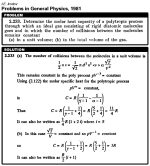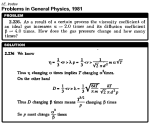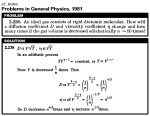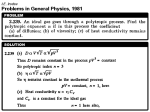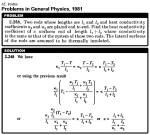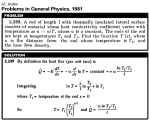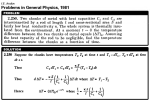| № |
Condition |
free/or 0.5$ |
| 621 | Determine the molar heat capacity of a polytropic process through which an ideal gas consisting of rigid diatomic molecules goes and in which the number of collisions between the molecules remains constant (a) in a unit volume; (b) in the total volume of the gas. |
|
| 622 | An ideal gas of molar mass M is enclosed in a vessel of volume V whose thin walls are kept at a constant temperature T. At a moment t = 0 a small hole of area S is opened, and the gas starts escaping into vacuum. Find the gas concentration n as a function of time t if at the initial moment n(0) = n0. |
|
| 623 | A vessel filled with gas is divided into two equal parts 1 and 2 by a thin heat-insulating partition with two holes. One hole has a small diameter, and the other has a very large diameter (in comparison with the mean free path of molecules). In part 2 the gas is kept at a temperature ii times higher than that of part 1. How will the concentration of molecules in part 2 change and how many times after the large hole is closed? |
|
| 624 | As a result of a certain process the viscosity coefficient of an ideal gas increases a = 2.0 times and its diffusion coefficient b = 4.0 times. How does the gas pressure change and how many times? |
|
| 625 | How will a diffusion coefficient D and the viscosity coefficient of an ideal gas change if its volume increases n times: (a) isothermally; (b) isobarically? |
|
| 626 | An ideal gas consists of rigid diatomic molecules. How will a diffusion coefficient D and viscosity coefficient n change and how many times if the gas volume is decreased adiabatically N=10 times? |
|
| 627 | An ideal gas goes through a polytropic process. Find the polytropic exponent n if in this process the coefficient (a) of diffusion; (b) of viscosity; (c) of heat conductivity remains constant. |
|
| 628 | Knowing the viscosity coefficient of helium under standard conditions, calculate the effective diameter of the helium atom. |
|
| 629 | The heat conductivity of helium is 8.7 times that of argon (under standard conditions). Find the ratio of effective diameters of argon and helium atoms. |
|
| 630 | Under standard conditions helium fills up the space between two long coaxial cylinders. The mean radius of the cylinders is equal to R, the gap between them is equal to ΔR, with ΔR << R. The outer cylinder rotates with a fairly low angular velocity ω about the stationary inner cylinder. Find the moment of friction forces acting on a unit length of the inner cylinder. Down to what magnitude should the helium pressure be lowered (keeping the temperature constant) to decrease the sought moment of friction forces n = 10 times if ΔR = 6 mm? |
|
| 631 | A gas fills up the space between two long coaxial cylinders of radii R1 and R2, with R1 < R2. The outer cylinder rotates with a fairly low angular velocity ω about the stationary inner cylinder. The moment of friction forces acting on a unit length of the inner cylinder is equal to N1. Find the viscosity coefficient η of the gas taking into account that the friction force acting on a unit area of the cylindrical surface of radius r is determined by the formula σ = ηr (∂ω/∂r). |
|
| 632 | Two identical parallel discs have a common axis and are located at a distance h from each other. The radius of each disc is equal to a, with a >> h. One disc is rotated with a low angular velocity ω relative to the other, stationary, disc. Find the moment of friction forces acting on the stationary disc if the viscosity coefficient of the gas between the discs is equal to η. |
|
| 633 | Solve the foregoing problem, assuming that the discs are located in an ultra-rarefied gas of molar mass M, at temperature T and under pressure p. |
|
| 634 | Making use of Poiseuille's equation (1.7d), find the mass of gas flowing per unit time through the pipe of length L and radius a if constant pressures p1 and p2, are maintained at its ends. |
|
| 635 | One end of a rod, enclosed in a thermally insulating sheath, is kept at a temperature T1 while the other, at T2. The rod is composed of two sections whose lengths are L1 a nd L2 and heat conductivity coefficients k1 and k2. Find the temperature of the interface. |
|
| 636 | Two rods whose lengths are L1 and L2 and heat conductivity coefficients k1 and k2 are placed end to end. Find the heat conductivity coefficient of a uniform rod of length L1+L2 whose conductivity is the same as that of the system of these two rods. The lateral surfaces of the rods are assumed to be thermally insulated. |
|
| 637 | A rod of length L with thermally insulated lateral surface consists of material whose heat conductivity coefficient varies with temperature as x = a/T, where a is a constant. The ends of the rod are kept at temperatures T1 and T2. Find the function T(x), where x is the distance from the end whose temperature is T1, and the heat flow density. |
|
| 638 | Two chunks of metal with heat capacities C1 and C2 are interconnected by a rod of length L and cross-sectional area S and fairly low heat conductivity x. The whole system is thermally insulated from the environment. At a moment t = 0 the temperature difference between the two chunks of metal equals (dT)0. Assuming the heat capacity of the rod to be negligible, find the temperature difference between the chunks as a function of time. |
|
| 639 | Find the temperature distribution in a substance placed between two parallel plates kept at temperatures Ti and T2. The plate separation is equal to 1, the heat conductivity coefficient of the substance x=sqrt(T). |
|
| 640 | The space between two large horizontal plates is filled with helium. The plate separation equals L = 50 mm. The lower plate is kept at a temperature T1 = 290 K, the upper, at T2 = 330 K. Find the heat flow density if the gas pressure is close to standard. |
|
